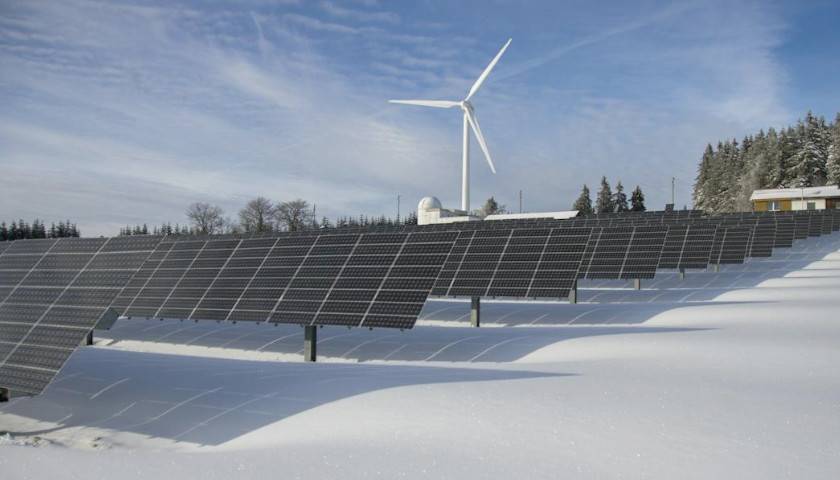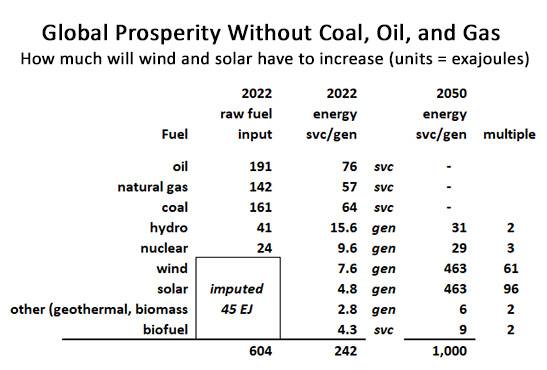by Edward Ring
In the most recent “Conference of the Parties,” otherwise known as the United Nations extravaganza that convenes every few years for world leaders to discuss the climate crisis, several goals were publicly proclaimed. Notable were the goals to triple production of renewable energy by 2030 and triple production of nuclear energy by 2050. Against the backdrop of current global energy production by fuel type, and as quantified in Part One, against a goal of increasing total energy production from 600 exajoules in 2022 to at least 1,000 exajoules by 2050, where does COP 28’s goals put the world’s energy economy? How much will production of renewable energy have to increase?
To answer this question, it is necessary to recognize and account for the fact that most renewable energy takes the form of electricity, generated through wind, solar, or geothermal sources. And when measuring how much the base of renewables installed so far will contribute to the target of 1,000 exajoules of energy production per year in order to realize—best-case scenario—800 exajoules of energy services, the data reported in the Statistical Review of Global Energy is profoundly misleading.
Without understanding how current renewables data as reported in summary charts can mislead an analyst into overstating its current contribution to global energy, it is impossible to accurately assess the true magnitude of the expansion in renewables needed to achieve a goal of 1,000 exajoules of global energy production per year. How the summary charts mislead is buried in the Appendix.
As the authors disclose (ref. page 56, “Methodology”) in the Appendix: “in the Statistical Review of World Energy, the primary energy of non-fossil based electricity (nuclear, hydro, wind, solar, geothermal, biomass in power and other renewables sources) has been calculated on an ‘input-equivalent’ basis – i.e. based on the equivalent amount of fossil fuel input required to generate that amount of electricity in a standard thermal power plant.”
It is difficult to overstate how important it is to not overlook this seemingly innocuous footnote.
In plain English, what they are saying is when they report (ref. page 9 “Primary Energy: Consumption by fuel”) the share of global energy contributed by all non-thermal sources—hydro, nuclear, wind, and solar—they gross up the lower, actual production number and report on the chart an imputed and much larger amount, calculated as if these four sources of energy were operating at the efficiency of thermal power inputs, i.e., at 40 percent efficiency.
Why? We may presume that the energy analysts preparing these charts gross up the contribution of non-thermal energy (Lawrence Livermore also does this, by the way, on their energy flowchart) in order to demonstrate how much fossil fuel production is being offset by using non-thermal sources. That seems innocent enough. But it’s misleading.
If we’re setting a goal of 1,000 exajoules of ultimate world energy production and assuming 80 percent of that 1,000 exajoules of energy input shall be realized as end-user energy services, then we have to examine how much usable energy wind, solar, hydro, and nuclear are actually being generated today. That means we need to know how much electricity they actually generate and send into the grid. An imputed, grossed-up number is not helpful.
Getting to 1,000 Exajoules per Year without Coal, Oil, and Gas
Fortunately, the actual amount of power currently generated by hydro, nuclear, wind, and solar can be found in the inner chapters of the Statistical Review. But it is important to recognize that if energy production shifts from thermal sources to electricity, it will still take at least 1,000 exajoules of power generation to produce 800 exajoules of energy services.
It must be again emphasized that it is an extraordinary assumption to project an 80 percent retention of energy from input into the grid to actual end use. For example, we might assume that from the generating plant, 5 percent was lost in transmission, another 5 percent lost from charging and subsequently discharging the electricity to and from utility-scale storage batteries, another 5 percent in the charge/discharge cycle through an onboard battery in an EV, and another 5 percent converting that electricity into traction from the electric motor. Those are extraordinarily optimistic numbers, using a best-case example. Is a heat pump that efficient, or an air conditioner, or a cooktop, or any number of appliances, farm machinery, industrial equipment, and other vital infrastructure? Definitely not yet, and quite possibly never.
The point here is 1,000 exajoules represents the absolute minimum to which global energy production must grow in the next 25 years if every person on earth is to have access to enough energy to enable prosperity and security. How do we get there? Let’s take the experts at their word and assume that use of coal, oil, and gas will be completely eliminated by 2050.
On the chart below, the assumptions governing the future mix of fuels worldwide adhere to the resolutions just made at the recent Conference of the Parties. That is, nuclear energy will be tripled, and use of oil, natural gas, and coal will be eliminated. To take some of the pressure off of the required expansion of solar and wind energy, for this analysis, the sacrilegious assumption is made to double hydroelectric capacity, double geothermal production, and double biofuel production. It won’t matter much. Here goes:
There’s a lot to chew on in this data, but it’s worth the effort. Because the facts they present are immutable and carry with them significant implications for global energy policy. The first column of data shows how much fuel was burned or generated worldwide in 2022—the raw fuel inputs, which total 604 exajoules.
The second column of data shows the number of energy services that reached end-users in 2022 in the form of heating, cooling, traction, light, communications, etc. It is clear that for thermal sources of energy, the lower numbers reflect the currently estimated degree of conversion efficiency worldwide, about 40 percent. But for non-thermal sources of energy (appended to the right with “gen,” signifying generated energy), these numbers are based on terawatt-hour reports featured in individual sections of the Statistical Review dedicated to those sources of energy. Converted from terawatt-hours to exajoules, these are the actual amounts of electricity that went into transmission lines around the world to be consumed by end users.
The third column of data calculates a hypothetical 2050 global fuel mix based on the agreed COP 28 targets. As seen in column 4 “multiple,” nuclear energy is tripled in accordance with COP 28. Also, in accordance with COP 28, use of coal, oil, and gas is eliminated. Not agreed to at COP 28, but to help reach the 1,000 exajoule target, production of geothermal and biofuel energy are both doubled. That leaves the remainder of the needed power to be provided (in this example) equally by wind and solar. It is reasonable to assume, based on everything they’re saying in Dubai and Davos, that this is the model. This is the logical realization of what they’re calling for.
These calculations yield an overwhelming reality check. Yet what assumption is incorrect? The target of 1,000 exajoules is almost certainly too low. Nuclear power is tripled, and hydropower and biofuel are both doubled. None of that is easy; in the case of biofuel, it could be an environmental catastrophe. But even if those other non-thermal sources of energy were to increase two to three times, without coal, oil, and gas, a stupefying expansion of wind and solar would be required. “Tripling” these renewables doesn’t even get us into the ballpark.
To deliver 1,000 exajoules of power to the world by 2050, for every wind turbine we have today, expect to see more than 60 of them. For every field of photovoltaics we have today, expect to see nearly 100 more of them. Is this feasible? Because from Dubai to Davos, this is what they’re claiming we’re going to do.
Confronted with these facts, even the most enthusiastic proponents of wind and solar energy may hesitate when considering the magnitude of the task. Eliminating production of fossil fuel entirely by 2050 ought to be seen, for all practical purposes, as impossible. The uptick in mining, the land consumed, the expansion of transmission lines, the necessity for a staggering quantity of electricity storage assets to balance these intermittent sources, the vulnerability of wind and solar farms to weather events including deep freezes, tornadoes, and hail, and the stupefying task of doing it all over again every 20-30 years as the wind turbines, photovoltaic panels, and storage batteries reach the end of their useful lives—all of this suggests procuring 90+ percent of global energy from wind and solar energy is a fool’s errand.
If coal, oil, and gas are phased out and it is unrealistic to expect nearly 1,000 exajoules of power to be delivered by wind and solar-generated electricity, what’s left? Part three of this series will examine the potential of the remaining energy alternatives—nuclear, hydroelectric, biofuel, geothermal—along with possible innovations that someday may change the rules.
– – –
Edward Ring is a senior fellow of the Center for American Greatness. He is also is a contributing editor and senior fellow with the California Policy Center, which he co-founded in 2013 and served as its first president. Ring is the author of Fixing California: Abundance, Pragmatism, Optimism (2021) and The Abundance Choice: Our Fight for More Water in California (2022).





